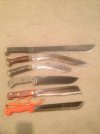- Joined
- Jun 17, 2006
- Messages
- 4,090
There isn't a machete specific forum so that's why this is in General. I was at a gun show this weekend and a vendor had a surprisingly good selection of machetes in different blade styles. I could actually use a quality machete but I didn't buy one because I'm unsure which blade styles are considered to be most useful.
My intended use would be clearing briars and heavy weeds, maybe some small locust saplings. Are there any particular blade designs that are better than others for this task?
My intended use would be clearing briars and heavy weeds, maybe some small locust saplings. Are there any particular blade designs that are better than others for this task?




